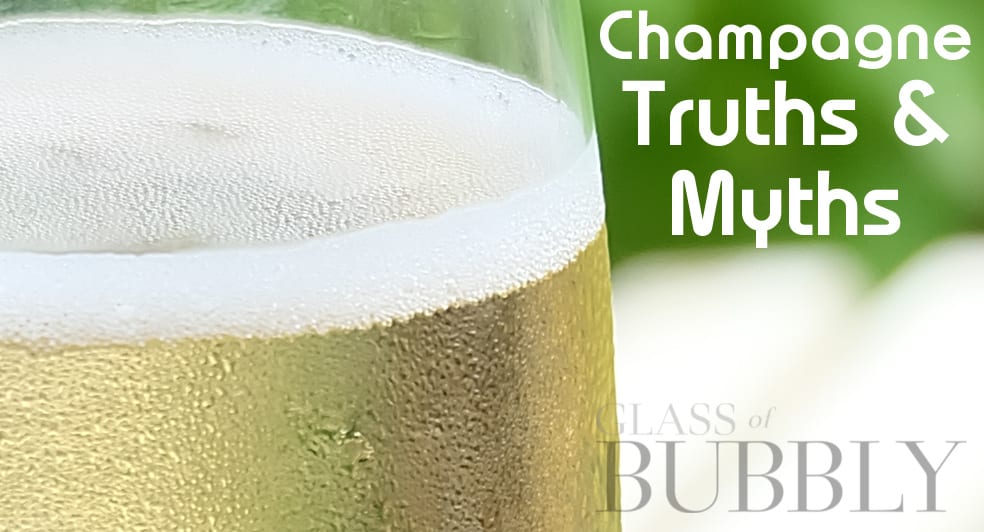Champagne Truths and Myths
8th September 2021

Champagne. Nine letters, two syllables, a region, a name, a wine and a passion…
There is something quite special about Champagne. Be it seen as a luxury, an aspiration, a celebration, a tasting experience, a hobby and for many, the benchmark. With some 34,300 hectares of vineyards, the Champagne region holds around 15,000 growers in two separate regions of Northern France found some 100 miles and beyond from Paris.
With so much information floating around about Champagne, what facts can we rely on and which should we simply see as myths? Let us take a look at a few well known and also lesser known:
- Champagne region is the biggest in France? In fact, this famous wine growing region only accounts for 3% of the total area under vine in France. The Languedoc region is the largest French wine producing area in terms of volume.
- Champagne can only be produced / made in France? This is correct, mostly. The designated (AOC) wine growing regions of Northern France for Champagne is the only place that his wine classification can be grown and produced, but… There is an exception to the rule book within California, USA which entitles that a ‘Semi-generic’ designation can be used to designate wines not from the original Champagne region as long as the name of the originating region appears on the label (26 U.S. Code § 5388 – Designation of wines).
- Dom Pierre Pérignon invented Champagne. This is the most used and shared story regarding the origins of Champagne along with the phrase ‘come quickly, I am tasting the stars‘ to signify the delight of his own discovery. It is though disputed that sparkling wine was first discovered by Englishman, Christopher Merret in 1662. You can make up your own mind which you think deserves the credit for being the founder of ‘Champagne‘.
- 49 million bubbles. Many times it is quoted about the number of bubbles in a bottle of Champagne and it is relatively the accepted 49 million that is rumoured to be the answer. To be honest, who knows, who has counted and who (though Fredrik Schelin is widely accredited with this) could have counted them!
- Champagne corks can kill. This is a fact I am afraid and one that is repeated globally fairly frequently. A Champagne cork is said to be able to reach a speed of 55 mph and if this cork hits you having just left the bottle then it will hurt or indeed kill you. More people are killed each year by flying Champagne corks than bites from poisonous spiders. The pressure behind a Champagne cork in the bottle is approximately 90 pounds per square inch, which is three times the amount of pressure in the tyre of a car!
- Champagne hangovers. Doesn’t all alcohol, if we indulge in them too much too soon, give us that dreaded next morning hangover with at least a raging thirst (dehydration) and an uncomfortable nights sleep? Many people have studied the effects of alcohol consumption and especially the effects of – Many will say you get drunk faster and suffer worse hangovers when drinking Champagne, the reason being the carbon dioxide in the wine helps to speed up the absorption of alcohol making you drunk faster and cause a stronger hangover effect the following morning.
- Vintage Champagne. When people see or hear the word vintage for wines they think the wine will be very old, this is not necessarily the case. Vintage in Champagne terms means that all the grapes used to make the wine in the bottle were grown in the same year – Selected years, set by the wine growers, are chosen to hold the name millesime / vintage and this is when the harvest is seen as a superior one. Each bottle will have the year of the vintage on and this could be something released only 4 years ago (legally, the minimum for vintage cuvees is three years ageing in the bottle). Most times a winemaker will keep his Champagne in the bottle ageing for 4-10 years so we can say that vintages are older wines, but not necessarily decades or centuries old!
- Flutes of coupes? I must say that serving Champagne in either a flute or a coupe is part and parcel of the experience, though there is a downside to this is you wish to fully appreciate the wine. Flutes do allow the wine to breathe and also restricts aromas, a coupe will do the opposite and ooze away too many aromas not allowing you to enjoy them. The best style of glass is a simple white wine glass with a bowl / tulip design so that the wine can breathe and capture the aromas for you to enjoy.
- Is Champagne Wine?
- Champagne is a type of wine. It is made from grapes that have been fermented to produce alcohol, and then it is bottled with added sugar and yeast. This process creates the carbonation you love in champagne. So, next time someone tries to tell you that Champagne isn’t really wine, set them straight!
- Expensive Champagne
- Now let’s move on to some of the myths about Champagne. One popular myth is that Champagne must be expensive in order to be good. This isn’t always true – there are many affordable Champagnes out there, that you can Shop at The Bottle Club, that are delicious. Another common myth is that you can only drink Champagne when it’s cold. In reality, you can drink it at room temperature too!
![]()
Christopher Walkey
Co-founder of Glass of Bubbly. Journalist and author focused on Champagne & Sparkling Wines and pairing them with foods.
